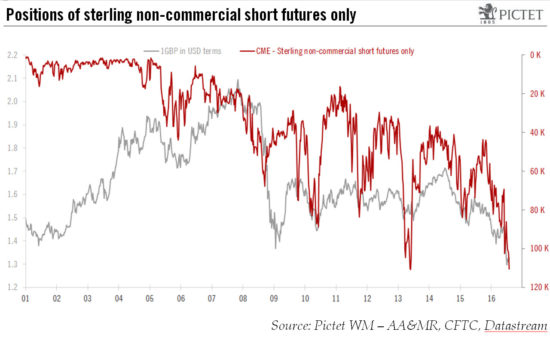Sterling quickly steadied after a lurch downward following the latest Bank of England (BoE) policy easing. But looming Brexit negotiations and the UK’s twin deficits cast a shadow over the currency On 4 August, the BoE delivered a broad easing package that beat market expectations. Furthermore, the BoE hinted at an additional rate cut later in the year (our scenario is for another 15bp rate cut in Q4 2016). The easing package delivered by the BoE was a more aggressive response to Brexit than the market had been anticipating, resulting in a broad move lower for sterling.However, after the short-term negative adjustment, sterling is likely to remain broadly stable in the next few months as the BoE is unwilling to consider negative rates and market positioning is very short GBP. Although the BoE also announced the expansion of its quantitative easing (QE) programme, it is far from open ended (the new QE package is only meant to last six months). Liquidity injections by the BoE via QE are therefore likely to have only a relatively mild effect on sterling.The longer-term prospects for sterling will rely heavily on the nature of the negotiations between the UK and the European Union, but the terms of Brexit will likely remain unknown in the coming months.
Topics:
Luc Luyet considers the following as important: Bank of England easing, Brexit negotiations, Macroview, Sterling exchange rate, UK twin deficits
This could be interesting, too:
Cesar Perez Ruiz writes Weekly View – Big Splits
Cesar Perez Ruiz writes Weekly View – Central Bank Halloween
Cesar Perez Ruiz writes Weekly View – Widening bottlenecks
Cesar Perez Ruiz writes Weekly View – Debt ceiling deadline postponed
Sterling quickly steadied after a lurch downward following the latest Bank of England (BoE) policy easing. But looming Brexit negotiations and the UK’s twin deficits cast a shadow over the currency
On 4 August, the BoE delivered a broad easing package that beat market expectations. Furthermore, the BoE hinted at an additional rate cut later in the year (our scenario is for another 15bp rate cut in Q4 2016). The easing package delivered by the BoE was a more aggressive response to Brexit than the market had been anticipating, resulting in a broad move lower for sterling.
However, after the short-term negative adjustment, sterling is likely to remain broadly stable in the next few months as the BoE is unwilling to consider negative rates and market positioning is very short GBP. Although the BoE also announced the expansion of its quantitative easing (QE) programme, it is far from open ended (the new QE package is only meant to last six months). Liquidity injections by the BoE via QE are therefore likely to have only a relatively mild effect on sterling.

The longer-term prospects for sterling will rely heavily on the nature of the negotiations between the UK and the European Union, but the terms of Brexit will likely remain unknown in the coming months.
Besides monetary policy, the most critical driver for the direction of sterling will be negotiations surrounding the UK’s exit from the European Union (EU). However, the shape and timeframe for Brexit will likely remain unknown for some months yet.
In our view, the GBP/USD rate since the 23 June referendum is broadly consistent with a rather soft Brexit, in the form of a deal that tries to minimise Brexit’s impact on the EU and UK economies. In the case of less friendly negotiations (hard Brexit), sterling would likely see further downwards pressure.
Notwithstanding Brexit, the fact that UK has the highest twin deficits (budget and current account) of any G10 country favours a long-term bearish bias on sterling. This is especially true as fiscal policy is expected to be loosened in the UK and foreign investment will be harder to attract given the decline in UK investment income.
